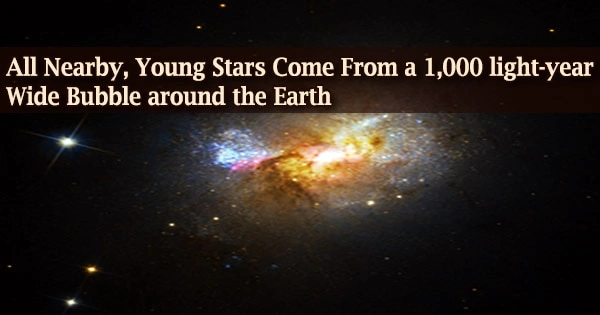The Earth is around by thousands of newborn stars in a gap that is 1,000 light years across, but how did those stars come into existence?
Astronomers from the Space Telescope Science Institute (STScI) and the Center for Astrophysics | Harvard & Smithsonian (CfA) reconstruct the evolutionary history of our galactic neighborhood in a paper that will appear in Nature on Wednesday (January 12, 2022). They demonstrate how a series of events that started 14 million years ago led to the creation of a massive bubble that is responsible for the formation of all nearby, young stars.
“This is really an origin story; for the first time we can explain how all nearby star formation began,” says astronomer and data visualization expert Catherine Zucker who completed the work during a fellowship at the CfA.
All newborn stars and star-forming regions within 500 light years of Earth dwell on the surface of a massive bubble known as the Local Bubble, according to the paper’s main illustration, a 3D spacetime animation. Scientists can now observe and comprehend the Local Bubble’s origins as well as its effects on the gas surrounding it, even though astronomers have known of its presence for decades.
The Source of Our Stars: The Local Bubble
The spacetime animation demonstrates how a succession of supernovae that started off 14 million years ago pushed interstellar gas outward, forming a bubble-like structure with a surface that is suitable for star formation. It does this using a wealth of new data and data science approaches.
Currently, the bubble’s surface is occupied by seven recognized star-forming regions, also known as molecular clouds dense regions of space where stars can form.
“We’ve calculated that about 15 supernovae have gone off over millions of years to form the Local Bubble that we see today,” says Zucker who is now a NASA Hubble Fellow at STScI.
This is an incredible detective story, driven by both data and theory. We can piece together the history of star formation around us using a wide variety of independent clues: supernova models, stellar motions and exquisite new 3D maps of the material surrounding the Local Bubble.
Professor Alyssa Goodman
The oddly-shaped bubble is not dormant and continues to slowly grow, the astronomers note.
“It’s coasting along at about 4 miles per second,” Zucker says. “It has lost most of its oomph though and has pretty much plateaued in terms of speed.”
The European Space Agency’s Gaia space-based observatory’s data was used to determine the bubble’s rate of growth as well as the past and present paths of the newborn stars developing on its surface.
“This is an incredible detective story, driven by both data and theory,” says Harvard professor and Center for Astrophysics astronomer Alyssa Goodman, a study co-author and founder of glue, data visualization software that enabled the discovery. “We can piece together the history of star formation around us using a wide variety of independent clues: supernova models, stellar motions and exquisite new 3D maps of the material surrounding the Local Bubble.”
Bubbles Everywhere?
“When the first supernovae that created the Local Bubble went off, our Sun was far away from the action,” says co-author João Alves, a professor at the University of Vienna. “But about five million years ago, the Sun’s path through the galaxy took it right into the bubble, and now the Sun sits just by luck almost right in the bubble’s center.”
The process of star formation is currently taking place all around the bubble’s surface as people watch from a location close to the Sun. Nearly 50 years ago, astronomers first believed that superbubbles were common throughout the Milky Way.
“Now, we have proof and what are the chances that we are right smack in the middle of one of these things?” asks Goodman.
According to statistics, it is extremely unlikely that the Sun would be located in the core of a large bubble if they were uncommon in our Milky Way Galaxy, she says.
Goodman compares the finding to the Milky Way, which has many holes like a very holey Swiss cheese. Supernovae blast holes out of the cheese, and new stars can form in the cheese surrounding the holes that dying stars leave behind.
The group’s next step is to map out more intergalactic bubbles to gain a complete 3D view of their locations, forms, and sizes. This includes co-author and Harvard doctorate student Michael Foley.
Astronomers will eventually be able to comprehend the function that dead stars play in the formation of new ones as well as in the structure and evolution of galaxies like the Milky Way by mapping out bubbles and their relationships to one another.
Zucker wonders, “Where do these bubbles touch? How do they interact with each other? How do superbubbles drive the birth of stars like our Sun in the Milky Way?”
Additional co-authors on the paper are Douglas Finkbeiner and Diana Khimey of the CfA; Josefa Gro?schedland Cameren Swiggum of the University of Vienna; Shmuel Bialy of the University of Maryland; Joshua Speagle of the University of Toronto; and Andreas Burkert of the University Observatory Munich.





